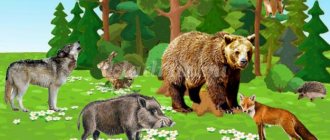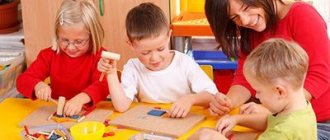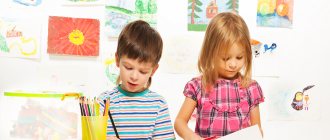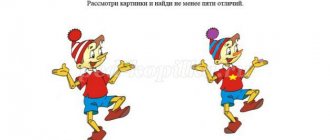OD summary on speech development on the topic: Autumn clothes, shoes. Senior group
OD summary on the development of the lexical-grammatical structure of speech and coherent speech in the senior group “Autumn clothes, shoes and hats”
Goal: development of the lexical-grammatical structure of speech and coherent speech of preschool children. Tasks: 1. Activation of the dictionary on the topic of clothing, shoes, hats. 2. Exercise in the formation of the category of the genitive case, constructions with the preposition C. 3. Mastering the verbal dictionary on the topic being studied, the verb “put on.” 4. Develop fine and gross motor skills, attention, memory. 5. Practice writing a descriptive story. 6. Develop the ability to listen to the answers of your comrades without interrupting. Equipment: subject pictures depicting hats, clothes, shoes.
Progress of the lesson
Speech therapist: Hello, children. Please tell me what time of year it is now? Children: Autumn. Speech therapist: Correct! What changes in nature occur in autumn? Children: The leaves turn yellow and fall, it becomes cold, the wind blows and it rains. Speech therapist: Well done! Speech therapist: What things should you wear in the fall? Children: Jacket, hat, trousers, boots... Speech therapist: Yes, you said everything correctly. Children, you probably guessed what we will talk about today in class. Children: Yes. Speech therapist: That's right, guys. Today we will talk about clothes, shoes and hats. Speech therapist: Guys, how can you call a jacket, scarf, sweater in one word? Children: Clothes. Speech therapist: How can you call a cap, hat, beret in one word? Children: Hats. Speech therapist: Guys, how can you call boots, boots, shoes in one word? Children: Shoes Speech therapist: Well done, children. You see how much clothing, hats, and shoes you know. Speech therapist: Please tell me, if we wear clothes in the fall, what are they? Children: These clothes are called autumn. Speech therapist: Well done, right. Speech therapist: Guys, now we’re going to play a game called “What should we wear for a walk?” Look, you have pictures, I will ask a question, and you must answer. Speech therapist: What will you wear, and what will Tanya wear? Child: I will wear a shirt, and Tanya will wear a dress. Speech therapist: What will you wear, and what will Vova wear? Child: I’ll wear a sweater, and Vova will wear trousers. Child: I’ll wear a dress, and the girl will wear a sundress. Child: I’ll wear shoes, and the boy will wear a T-shirt. Speech therapist: Well done, guys. Let's play the game “Choose a Word” with you. We will select adjectives for the words: dress (which?), coat (which?), jacket (which?), sweater (which?), boots (which?). Children: The dress is elegant, red, new, beautiful... . The coat is warm, autumn, brown... The jacket is comfortable, autumn, warm, bright... . Knitted woolen sweater, yellow, comfortable... . Leather boots, comfortable, black... . Speech therapist: Okay, well done. Now let’s play the game “Say the opposite”, I say the word, and you say the opposite. Speech therapist: Put on Children: Take off Speech therapist: Put on shoes Children: Take off shoes Speech therapist: Buy Children: Sell Speech therapist: Tie up Children: Untie. (fasten - unfasten, iron - wrinkle, hang - take off, put on shoes - take off shoes). Speech therapist: Children, please tell me what can be done with clothes. Children: Clothes can be put on, worn, taken off, sold, bought, sewed, knitted, dressed, buttoned, ironed, darned, mended, patched, washed, dried, hung. Speech therapist: Well done! Guys, what elements or details of clothing, shoes, and hats do you know? Children: A detail of clothing is a pocket (collar, cuff, button, eyelet, fastener, button, belt, zipper, trouser leg, sole, heel, strap, brim. Speech therapist: Okay, you know a lot of details of clothing, shoes and hats. Look on your pictures and name the items of shoes and clothing, and also list the details of the named things. Child: I have a shirt with a collar. Child: I have a skirt with a belt. Child: I have a scarf with tassels. Child: I have shoes with heels. Speech therapist : Well done, children. You coped well with the task. Speech therapist: Let's rest a little. Together we help mom, We rinse the laundry ourselves. One, two, three, four - we stretched, bent over. We did a good job. (We repeat the movements after the speech therapist) Speech therapist: A little rested, sat down nicely in our seats, keeping our backs straight. Speech therapist: And now, guys, we will write a story - a description about a shirt, dress, coat, boots. According to plan: What is it? When are they worn? What are the clothes made of? Parts of clothing? Speech therapist: Please tell me what we talked about in class? Children: We talked about shoes, clothes and hats. Speech therapist: Right, what else did you do during the lesson? Children: Named details of clothing, performed physical exercises. for a minute, we played the game “Say it the other way around”, choosing words for clothes. Speech therapist: Well done, everyone answered well in class today. The lesson is over. Goodbye.
We recommend watching:
Summary of a lesson on speech development in the senior group on the topic: Autumn Plan - summary of educational activities for preschoolers of the senior group: In the land of fairy tales Summary of educational activities in the senior speech therapy group Summary of OD in the senior group. What kind of grain is this, not just a simple one - golden
Similar articles:
Lesson summary - traveling in kindergarten for the International Day for Older Persons
Entertainment “Visiting Autumn”. Senior group
Summary of a lesson on speech development on the topic “Clothing”
Lesson notes for junior group 2
on the topic of:
"Cloth"
Program content: consolidation of the general concept of “clothing”; introduce children to the classification of clothing by season;
improve children's communication skills; activation and enrichment of vocabulary; develop attention, memory, perception; educate children to be neat and careful about things.
Materials:
pictures depicting clothes for all seasons; pieces of cotton wool.
Progress of the Lesson:
Hello guys! I'm very glad to see you all! Let's all say hello
Exercise “Good Friend”
Children stand in a circle and hold hands. They say the words in chorus:
Hello Friend! (shake hands)
How are you doing? (they throw up their hands in surprise)
I missed you (they press their hands to their chest.)
You have come (they hold hands again.)
Fine! (converge to the center, hugging.)
(children sit on chairs)
Educator:
Now listen to the poem and guess what we are going to talk about today
Unfortunately, trousers and dresses do not have sleeves. But arms, legs, neck, head grow all the time. Boys and girls are getting big, They need clothes made to measure for them. The masters used needles, scissors, and an iron. They took up the sewing skillfully. Many fast, dexterous hands. Receive your order! Everything is to measure, just right. A. Kardashova
(Children's answers)
Educator:
That's right, this poem talks about clothes. People dress in different clothes at different times of the year. Look on the table there are pictures of clothes, you need to determine what kind of clothes belong to what time of year.
(children's answers)
Educator:
Well done! Now let's play with our fingers a little
Finger gymnastics “Clothes”
I’ll put on boots, (We point to the legs, torso, head.)
Jacket and hat.
And on each hand (One hand with straightened fingers up, the other runs along the little finger and the edge
palms, showing the direction of putting on gloves.)
I'll pull on the glove. (Change hands.)
Educator:
Tell me, do you know how to care for clothes?
If it is torn it needs to be......(sewn up)
If it’s wrinkled you need to……(stroke it)
If it gets dirty, it needs to……..(wash)
And if a button comes off, you need to……..(sew it on)
Phys. Just a minute
And now we will go for a walk, put on our pants, jacket, hat, fur coat, fasten the buttons (children imitate dressing). Ask each other to tie a scarf. Let's put on mittens.
Educator:
Tell me correctly, what are you wearing? Let's go for a walk, look how sticky the snow is!
Educator:
Children, snow falls on your hands (put a piece of cotton wool on each palm). Let's blow on snowballs.
Educator:
Tell me, what did we talk about in our lesson? (children's answers)
Theme “Autumn. Man, clothes, shoes, hats"
(2nd week)
Task 1. Parents are recommended:
draw the child’s attention to what time of year has arrived, what changes have occurred in the weather, compare the weather in summer and autumn;
explain why people wear different clothes, shoes, and hats in different seasons;
explain to the child the concepts of “seasonal clothing”, “shoes”, “hats”;
ask your child: “Why do you need to wear rubber boots, a jacket, a cap in the fall, and a Panama hat, sandals, and shorts in the summer?”;
Together with your child, carefully consider the clothes, shoes, hats that each family member wears in the fall, and the material from which they are made; pay attention to its quality and design;
fix the names of clothing parts (collar, pockets, etc.).
Task 2. Name autumn clothes, shoes and hats.
Task 3. Guess riddles (learn by choice).
· We always walk together, looking alike like brothers.
We are under the table at dinner, and under the bed at night. (Shoes)
· In order not to freeze, five guys sit in a knitted stove. (Gloves)
· If it’s raining, we don’t bother – we splash briskly through the puddles.
The sun will shine - we will stand under the coat rack. (Boots)
· I’m sitting astride, I don’t know who I’m on.
If I meet an acquaintance, I’ll jump off and greet him. (A cap)
Task 4. Didactic game “The fourth odd one”.
Jacket, rubber boots, gloves, hat.
Task 5. Didactic game “Correct the mistake” (understanding the meanings of possessive pronouns).
My boots, my hat, my gloves, my scarf... .
Task 6. Didactic game “Name which ones” (formation of relative adjectives): rubber boots - rubber boots; wool hat - wool; leather gloves - leather... .
Task 7. Count the objects (coordination of nouns with numerals): one scarf, two scarves, three scarves, four scarves, five scarves; one hat, two hats... five hats; one coat, two coats... five coats.
Task 8. Answer the question: “What can be considered in pairs?” (coordination of nouns with numerals): one pair of boots, two pairs of boots... five pairs of boots (socks, stockings, boots, shoes, gloves).
Task 9. Write a descriptive story about autumn clothes, shoes, hats (optional).
This is a jacket. These are warm clothes. It is worn in spring or autumn. This jacket is red. She has a hood. It's waterproof. It can be worn in the rain. It is fastened with a zipper.
Theme "Home. Furniture"
(3rd week)
Task 1. Parents are recommended:
during a joint walk around the city (village), look at residential buildings with your child, noting that there are different types of houses: one-story and multi-story, stone and wooden;
carefully examine the house in which the child lives, count how many floors it has, what floor he lives on, whether there is an elevator in the house and what it is needed for, remember the home address;
in the illustrations, consider houses that were built in large cities and in rural areas;
take your child on a “tour” around your apartment, paying attention to how many rooms there are in it (kitchen, bathroom, toilet room, hallway, utility rooms), explaining their purpose;
consider the furniture in each of these rooms, remembering its features and purpose;
tell your child riddles about furniture.
Task 2. Learn the poem.
New house
The new house is opposite the school. We live in a new house. We run up the stairs and count the floors: One - floor, two - floor, three, four - we are in the apartment.
Task 3. Didactic game “Name which house” (formation of complex words): house - one-story, two-story, three-story ... multi-story. (Explain to the child the meaning of the phrase “high-rise building.”)
Task 4. Change the word “window” in the context of a sentence (exercise in case and prepositional agreement).
The house has a big... There is no… in the house. I approached…. I dream big….I have flowers growing under….
Task 5. Guess the riddle.
· Who leaves, who comes - everyone leads her by the hand. (Door)
Task 6. Tell us what furniture is in the kitchen, bedroom, and living room. (Write a descriptive story about some type of furniture of your choice.)
This is a sofa. He is standing in the living room. It is soft, beautiful, comfortable. It has polished wooden arms and legs. You can sit or lie on the sofa.
Task 7. Didactic game “The fourth odd one.” Kitchen table, stools, buffet, bed.
Task 8. Find related words. Table - table top, dining room, table, table, table (lamp).
Task 9. Didactic game “Name which one...” (formation of relative adjectives).
The cabinet is made of wood, which means it is wooden.
The bed is made of iron,...
The sofa is made of leather,...
The chair is made of plastic,...
Task 10. Make up sentences with the word table, using “small” words (prepositions) in, on, under, at, for, from, to, between.
Task 11. Lay out figures from matches according to the pattern.
· They sit on a stool at the table, and without it our home is uncomfortable.
· We will put a crib in the bedroom and we will sleep sweetly on it.
· There is a large window in our room, I can see the lawn from it.
Task 12. Count the different types of furniture (coordination of numerals with nouns): one chair, two chairs... five chairs.
Task 13. Make a word from letters, guess what is hidden in the drawn object.
Task 14. Read the isograph (House).




